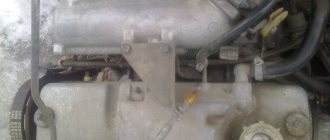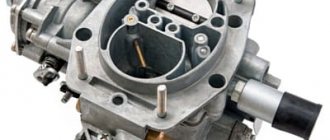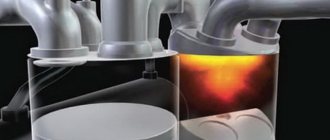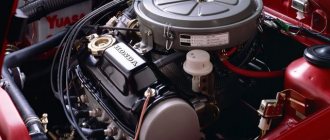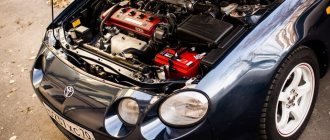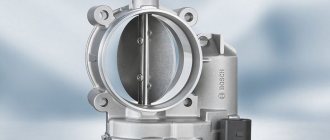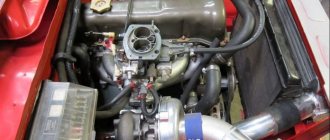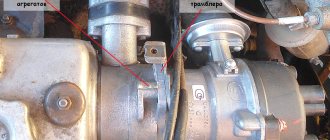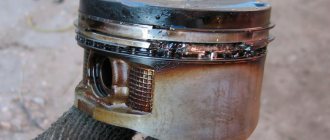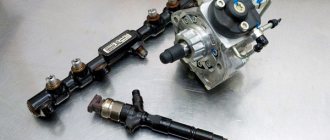Engine knock can lead to significant wear of engine parts such as the cylinder head gasket, elements of the cylinder-piston group, pistons, cylinders and other parts. All this significantly reduces the resource of the power unit until it completely fails. When this harmful phenomenon occurs, it is necessary to diagnose the reason why detonation occurred as quickly as possible and get rid of it. How to do this and what to pay attention to - read on.
What is detonation
Detonation is a disruption of the combustion process of the fuel mixture in the combustion chamber, when combustion does not occur smoothly, but explosively. At the same time, the speed of propagation of the blast wave increases from standard 30...45 m/s to supersonic 2000 m/s (exceeding the speed of sound by the blast wave is also the cause of the pop). In this case, the air-fuel mixture explodes not from a spark coming from a spark plug, but spontaneously, from high pressure in the combustion chamber.
Naturally, a powerful blast wave is very harmful to the cylinder walls, which overheat, the pistons, and the cylinder head gasket. The latter suffers the most and during the detonation process the explosion and high pressure simply burn it out (in slang it is called “blowing out”).
Detonation is typical for engines running on gasoline (carburetor and injection), including those equipped with gas-cylinder equipment (LPG), that is, running on methane or propane. However, most often it occurs in carburetor cars. Diesel engines operate according to a different scheme, and there are other reasons for this phenomenon.
Causes of engine detonation
As practice shows, detonation most often occurs on old carburetor engines, although in some cases this process can also occur on modern injection engines equipped with an electronic control unit. Reasons why detonation may occur include:
- Excessively lean air-fuel mixture . Its composition can ignite even before a spark enters the combustion chamber. At the same time, high temperatures provoke the occurrence of oxidative processes, which are the cause of the explosion, that is, detonation.
- Ignition earlier . With an increased ignition angle, the processes of ignition of the air-fuel mixture begin even before the piston hits the so-called top dead center.
- Using the wrong fuel . If gasoline with a lower octane number than prescribed by the manufacturer was poured into the car tank, then there is a high probability of a detonation process. This is explained by the fact that low-octane gasoline is more chemically active and enters into chemical reactions faster. A similar situation will occur if, instead of high-quality gasoline, some kind of surrogate like condensate is poured into the tank.
- High compression ratio in the cylinders . In other words, coking or other contamination in the engine cylinders, which gradually accumulates on the pistons. And the more carbon deposits there are in the engine, the higher the likelihood of detonation occurring in it.
- Faulty engine cooling system . The fact is that if the engine overheats, the pressure in the combustion chamber can increase, and this, in turn, can cause fuel detonation under appropriate conditions.
The knock sensor is like a microphone
These are common reasons that are typical for both carburetor and injection engines. However, there may be another reason for an injection engine - failure of the knock sensor. It supplies the corresponding information to the ECU about the occurrence of this phenomenon and the control unit automatically changes the ignition angle in order to get rid of it. If the sensor fails, the ECU will not do this. At the same time, the Check Engine light on the dashboard will be activated, and the scanner will display an engine knock error (diagnostic codes P0325, P0326, P0327, P0328).
Currently, there are many different options for flashing the ECU in order to reduce fuel consumption. However, their use is not the best solution, since there are often cases when such flashing led to dire consequences, in particular, incorrect operation of the knock sensor, that is, the engine control unit simply turned it off. Accordingly, if detonation does occur, the sensor does not report it and the electronics do nothing to eliminate it. Also, in rare cases, damage to the wiring from the sensor to the ECU may occur. In this case, the signal also does not reach the control unit and a similar situation occurs. However, all these errors can be easily diagnosed using an error scanner.
There are also a number of objective factors that influence the occurrence of detonation in individual engines. In particular:
- Engine compression ratio. Its importance is determined by the design features of the internal combustion engine, so if the engine has a high compression ratio, then theoretically it is more prone to detonation.
- Shape of the combustion chamber and piston crown. This is also a design feature of the engine, and some modern small but powerful engines are also prone to detonation (however, their electronics control this process and detonation in them is rare).
- Forced engines. They usually have a high fuel combustion temperature and high pressure, and accordingly, they are also prone to detonation.
- Turbocharged engines. Similar to the previous point.
As for detonation on diesel engines, the cause of its occurrence may be the fuel injection advance angle, low quality diesel fuel, or problems with the engine cooling system.
The operating conditions of the machine can also cause detonation. In particular, the engine is more susceptible to this phenomenon provided that the car is driving in a high gear, but at low speed and engine speed. In this case, a high degree of compression occurs, which can provoke detonation.
Some car owners also strive to reduce fuel consumption, and to do this they reflash the ECU of their cars. However, after this, a situation may arise where a poor air-fuel mixture reduces the dynamics of the car, while the load on its engine increases, and at increased loads there is a risk of fuel detonation.
What reasons are confused with detonation?
There is a concept called “glow ignition”. Many inexperienced car enthusiasts confuse it with detonation, since with glow ignition the internal combustion engine continues to operate even when the ignition is turned off. In fact, in this case, the air-fuel mixture is ignited by heated engine elements and this has nothing to do with detonation.
Another phenomenon that is mistakenly believed to be the cause of engine knocking when the ignition is turned off is called dieseling. This behavior is characterized by short-term engine operation after turning off the ignition at an increased compression ratio or using fuel that is inappropriate for detonation resistance. And this leads to spontaneous ignition of the air-fuel mixture. That is, ignition occurs as in diesel engines, under high pressure.
Can a car engine detonate when turned off: let’s understand the aspects
It is wrong to classify uneven engine operation or any other knocking as a sign of detonation. To avoid mistakes, the best option would be to find out what the detonation mode sounds like in practice. For example, watch thematic video files.
Dieseling
As already noted, an undesirable phenomenon can appear exclusively on a functioning motor. How then to qualify the operation of the power plant with the ignition off? The mechanics' answer is short - dieseling. Its nature is different: self-ignition of gasoline, identical to the working process of a diesel engine.
Beginners who have caught up on their knowledge base on gasoline internal combustion engines will immediately object, citing a couple of arguments “against”: high-octane fuel has poor self-ignition ability, and the compression ratio in a gasoline engine is lower. All this is true, but when the unit is stopped, favorable conditions are created for dieseling.
- Fuel supply to the cylinders.
- Low crankshaft speed.
In reality the process looks like this. The power plant is turned off, the crankshaft rotation speed drops, fuel is supplied. The time allotted for ignition of the mixture increases.
Under such conditions, a spark from a spark plug is not needed to ignite the fuel - a gradual increase in pressure and temperature is sufficient. After completing the power stroke, the crankshaft speed increases, and self-ignition does not occur. Then the frequency drops again and dieseling occurs again. And so on for several cycles of “twitching”.
Harm or benefit
Unlike knocking when rocking the steering wheel, there is nothing dangerous about the engine running unstably after being de-energized. On the contrary, the presence of this effect indirectly confirms the good tightness of the combustion chamber, which indicates the general serviceability of the internal combustion engine. This phenomenon can only occur on carburetor engines, because on injection power plants the fuel supply stops when the ignition is turned off.
Hence the conclusion - the absence of twitching after stopping the unit is not at all a sign of poor condition. By the way, a properly tuned and well-maintained carburetor protects the engine from diesel build-up. This is realized using the electromagnetic valve of the EPH system, which, in good condition, shuts off the supply of fuel to the cylinders when the internal combustion engine is turned off.
Isn't this a glow ignition?
Experienced drivers often replace the concept of diesel engine with glow ignition (KI), which is fundamentally considered incorrect. Elementary differences are revealed by the definition of a short circuit - this is the ignition of the fuel-air mixture from a heated source, which can be:
- Overheated spark plug surface.
- Exhaust valve.
- Nagar.
As has already been determined, the engine shows signs of detonation during shutdown due to self-ignition of the fuel assembly during its compression (the spark plug is de-energized).
Glow ignition implies the presence of deviations precisely when the spark plug is working: heated surfaces or a layer of carbon deposits ignite the mixture earlier than necessary. The consequences of a short circuit are dangerous. It may cause:
- Melting of candles.
- Overheating of pistons.
- Valves melting.
It is noteworthy that the “glow” motors operate stably throughout the entire operating speed range. Stability is explained by the fact that the temperature of a heated source continues to increase and maintain.
Signs of detonation
There are a number of signs by which you can indirectly determine that detonation is occurring in the engine of a particular car. It’s worth mentioning right away that some of them may indicate other breakdowns in the car, but it still makes sense to check for knocking in the engine. So, the signs include:
- The appearance of a metallic sound from the engine when it is running . This is especially true when the engine is running under load and/or at high speeds. The sound is very similar to what happens when two iron structures hit each other. This sound is precisely caused by the blast wave.
- Decrease in engine power . Usually, in this case, the engine does not operate stably, it may stall when idling (this is important for carburetor cars), it takes a long time to gain speed, and the car’s dynamic characteristics drop (it does not accelerate, especially if the car is loaded).
Diagnostic scanner Rokodil ScanX for connecting to the car ECU
It also makes sense to give signs of failure of the knock sensor. As in the previous list, signs may indicate other breakdowns, but for injection machines it is better to check the error using an electronic scanner (the most convenient way to do this is with a multi-brand Rokodil ScanX , which is compatible with all cars from 1993 onwards and allows you to connect to a smartphone on iOS and Android via Bluetooth). Such a device will make it possible to see the indicators of the knock sensor and others in real time.
So, signs of a knock sensor failure:
- Unstable engine operation at idle speed;
- a drop in engine power and in general the dynamic characteristics of the car (accelerates poorly, does not pull);
- increased fuel consumption;
- Difficulty starting the engine, this is especially noticeable at low temperatures.
In general, the symptoms are identical to those that occur with late ignition.
Where to look and how to check the knock sensor
In order to check it, you also need to know where the VAZ-2110 knock sensor is located. Everything is simple here; so that it can effectively capture vibrations, it is placed on the cylinder block. Its location largely depends on the design features of the motor itself.
On 8-valve engines it is usually located in the line of sight and is usually easy to get to. Therefore, it is not difficult to determine where the knock sensor is located on a VAZ-2107 (injector). It is installed on the exhaust manifold side and consists of a massive washer with wiring going to it and secured to the engine with a bolt.
But on 16-valve engines, the installation location is slightly different than the location of the knock sensor on the VAZ-2107 (injector). Due to the fact that the block head is much more massive, the sensor is located lower - under the exhaust manifold, so access to it is limited, and often it can only be reached from under the car on an overpass or inspection hole.
And although the location of the motor may differ slightly due to the design of the motor, its connection is always identical. Thus, the connection diagram for the VAZ-2109 knock sensor with an injection engine is the same as on the 2114 model.
Checking the VAZ-2110 knock sensor can be done in two ways.
The first of them implies the presence of a tester switched to measuring resistance (measurement level - up to 2 kOhm).
Checking the knock sensor with a tester
To check, you just need to disconnect the wiring block from the sensor and connect a tester to the sensor contacts. Then you should apply light blows with a wrench to the DD fastening bolt and monitor the readings on the tester display.
After connection, the display will show a certain resistance value of the sensor. At the moment of impact on the bolt, the resistance will increase sharply, but then return to the old value. If this does not happen (the resistance does not rise or does not return), the sensor is faulty and requires replacement.
The second method does not require any equipment and is more effective. To carry it out, you need to start the engine and set the speed to 2000 rpm. Then take an open-end wrench, you can use a small hammer with a metal attachment (if access to the DD is limited) and strike the fastening bolt. If the DD is in good working order, after the impact, the engine speed should drop, since such an impact will be regarded by the sensor as detonation and the ECU, based on its signals, will reduce the ignition angle. After the impact on the bolt stops, the speed should be restored. If this does not happen, the DD is faulty.
Consequences of detonation
As mentioned above, the consequences of detonation in a car engine are very serious, and under no circumstances should repair work be delayed, because the longer you drive with this phenomenon, the more damage the engine and its individual elements are susceptible to. So, the consequences of detonation include:
- Cylinder head gasket combustion . The material from which it is made (even the most modern ones) is not designed to work under conditions of elevated temperature and elevated pressure that arise during the detonation process. Therefore, it will fail very quickly. A broken cylinder head gasket will lead to other problems.
- Accelerated wear of elements of the cylinder-piston group . This applies to all its elements. And if the engine is no longer new or has not undergone a major overhaul for a long time, then this can end very badly, up to its complete failure.
- Cylinder head breakdown . This case is one of the most difficult and dangerous, but if you drive for a long time with detonation, then its implementation is quite possible.
Burnt cylinder head gasket
Damage and destruction of the piston
- Burnout of piston/pistons . In particular, its bottom, lower part. However, it is often impossible to repair it and will only need to be completely replaced.
- Destruction of jumpers between rings . Under the influence of high temperatures and pressure, they can be one of the first to break down among other engine parts.
Cylinder head breakdown
Piston burning
- Connecting rod bend . Here, similarly, in conditions of an explosion, its body can change its shape.
- Burning valve plates . This process happens very quickly and has unpleasant consequences.
Consequences of detonation
Piston burnout
As can be seen from the list, the consequences of the detonation process are the most serious, therefore the engine should not be allowed to operate under its conditions; accordingly, repairs must be performed as quickly as possible.
How to keep your engine alive
First of all, you need to know what to do if the engine does not stall after turning off the ignition. First of all, you need to quickly engage the gear and, while holding the brake pedal, release the clutch. This will help stop the engine and avoid the unpleasant consequences of detonation. Sometimes it's better to sacrifice the clutch disc than the entire engine. After this, it is recommended to check the serviceability of the cooling system and eliminate the cause of overheating.
To avoid detonation, it is necessary to use only fuel that is prescribed by the manufacturer. This does not necessarily apply to all cars. The main requirement is to use only high-quality gasoline, which can be found at trusted gas stations. You should not fill your car with fuel that costs 5-10 rubles less than the market price. Rest assured, this is bad gasoline.
If gasoline is in order, then check the ignition timing. It must correspond to the position of the pistons at certain times. Ignition too early or late always negatively affects the operation of the power plant. Also, check the spark plug model. If any other brand is installed, then pick up the car's operating instructions, which should indicate the characteristics of the spark plugs you need.
That's all that can be done for the engine if it detonates after turning off the ignition. If you have not found a solution to your problem here, then it is recommended to visit a car service center, where you will be provided with a more detailed diagnosis and solution to the problem.
